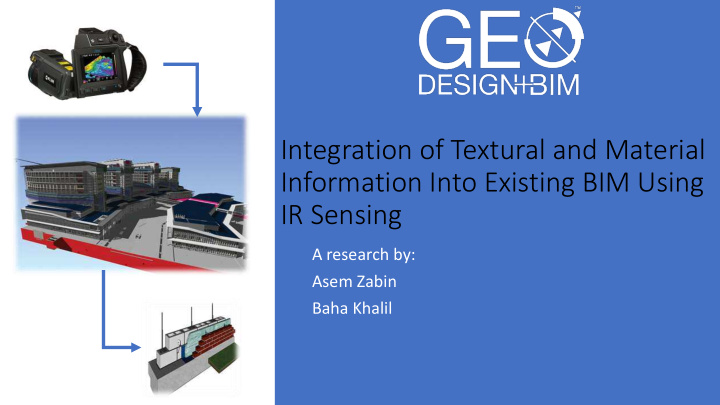



Integration of Textural and Material Information Into Existing BIM Using IR Sensing A research by: Asem Zabin Baha Khalil
Asem Zabin • Senior BIM Engineer at iTech Management Consultancy • Master of Science in Civil Engineering (MSCE) • Winner of the BIM For Innovation Award for Hyperloop Competition Area of interests: BIM for Infrastructure, Satellite Remote Sensing, As-Built BIM, BIM for FM, Post-construction BIM analysis Presenters Background Baha Khalil • Data Scientist at Unilever • Master of Science in Mathematics Area of interests: Convex optimization, Neural networks
Contents Problem statement IR Camera Texture analysis Math + case study Q&A
The Problem… 1 2 3 4 Why do we need As- As-built BIM is now done Surface Materials? Solution built BIM ? using laser scanners. Texture Homogeneity? • A Semi-automated method that is able to identify an • Limitations : unknown material and texture • laser scanners are limited and then integrate it with BIM. (Only geometry is identified)
Introduction As-Built • Definition: • Set of drawing and documents submitted by a contractor upon completion of a project or a particular job. • Reflect all changes made in the specifications and working drawings during the construction process. • Show the exact dimensions, geometry, and location of all elements of the work completed under the contract. • Also known as “record drawings” or “as is”. • Applications
As-Built Drawings • Rolls of drawings from the architect and engineers • Folders of equipment information for each type of equipment • 2D CAD Files Problem Statement
Current Data Acquisition Methods • Use of Barcodes in Construction to extract location information of objects • Radio Frequency Identification (RFID) tags • Laser Scanners or Light Detection And Ranging (LiDAR) • Photogrammetry
Remote Sensing, Infrared (IR) • Remote Sensing is the science and art of capturing information about objects, areas, or a phenomenon through the analysis of data acquired by device that is not in physical contact with the object, area or the phenomenon. • Infrared (IR) sensing is a form of remote sensing that employs electromagnetic radiations (EMR) between the visible and microwave radiations in the wavelength range from 700 nanometer at the edge of the red to about 1 mm.
Thermal IR Camera • Advantages in Construction: - It’s contactless, therefore nondestructive and reactionless. - It can be used to measure objects in very hot and difficult-to-access areas. - It allows for rapid data acquisition. - It measures the temperature of a solid-state body surface not the surrounding atmosphere.
Texture • Image texture is the frequency of tonal change of an image • Smoothness • Coarseness • Heterogeneity of classes • Contrast • Uniformity
Over the past decade, multiple striving efforts have been made to make computers acquire, understand, index, and interpret images expressing a wide variety of concepts, with much progress The objective is to retrieve texture with high accuracy Texture Extraction utilizing the least complicated computational approaches. A main form of image processing is image classification, which means segmenting the image into homogeneous zones and labeling the resulted zones with distinct class labels. Previous Researches
Edge Detection Machine Learning Previous Researches
Objectives • Extract material and textural information of an existing building interior walls using a thermal infrared camera. • Develop a framework for representing, organizing, and integrating the acquired material and textural data into the BIM. • Perform basic analysis on the rich BIM after integrating the new information to explore the advantages and limitations of the study for the industry.
Methodology 1.Take the picture of the unknown structure 2.Feed the image to the code 3.Algorithm will identify the materials in the provided images
Methodology
Materials Identification
Texture Identification
Material and Texture Identification Using Gaussian Mixture Models (GMM)
Normalized Radiance Values of Different Walls Materials Material and Texture Identification Using Gaussian Mixture Models (GMM)
Gaussian Mixture Models (GMM) for Concrete & Gypsum board Material and Texture Identification Using Gaussian Mixture Models (GMM)
Data Acquisition (Gypsum Board)
Data Acquisition (Concrete)
Data Acquisition (Concrete)
An algorithm which automatically extracts textural information was developed and applied, needed for identification of the walls. Feature Extraction This texture segmentation algorithm splits the image into different homogeneous texture regions
Exploration
Materials & Methodology Data Analysis: Monte Carlo Simulation • Monte Carlo Simulation is a modeling and simulating technique that generates several scenarios and gathers relevant statistics in order to assess relationship between the variable in question and a model of interest. • This method is often used when the model is nonlinear, or involves more than just a couple uncertain parameters. In each scenario, different means and standard deviations were simulated and the relationship between them was noted. Bell-shape distribution of Radiance values
Results Data Integration in BIM
Results Data Integration in BIM
Results Data Integration in BIM
Results Data Integration in BIM
Results Data Integration in BIM
Results Data Integration in BIM
Conclusions Integration Thermal with BIM Image Model Acquisition State of Art Artificial Intelligence • Feature Extraction (Interior Walls) • Data Analysis • Testing and Validation The proposed method used thermal infrared sensing to capture thermal images of the interior walls of an existing building. These images were then processed, and only wall features were extracted using a texture feature extraction algorithm. The resulted sub-images were then transformed into temperature values at each pixel of the interior walls.
Conclusions Integration Thermal with BIM Image Model Acquisition State of Art Artificial Intelligence • Feature Extraction (Interior Walls) • Data Analysis • Testing and Validation A statistical correlations between the mean and standard deviation of interior gypsum and concrete were obtained through a Monte Carlo simulation approach. The extracted texture and material information were then integrated in the BIM Model.
Conclusions Texture Rich BIM models can be used in LIVE assessment of building conditions in relation to energy efficiency and water and waste systems leaks.
Recommend
More recommend